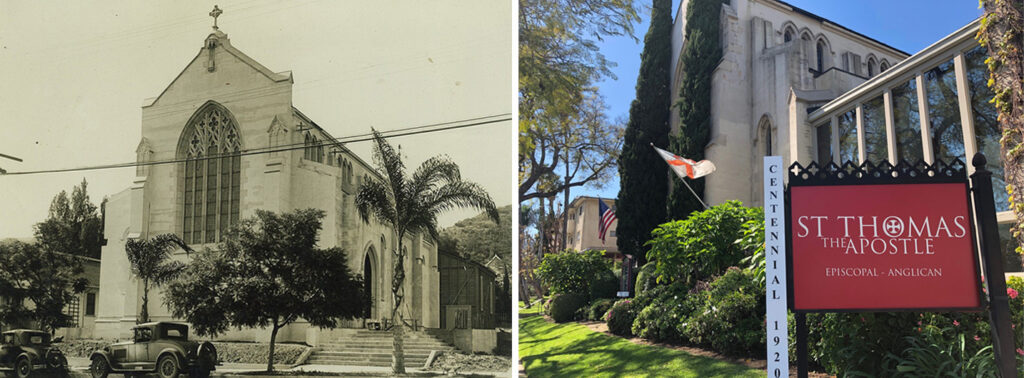
At the corner of Hollywood Boulevard and Gardner Street, St. Thomas the Apostle Episcopal Church marks 2020 as its parish centennial year. The landmark church was completed in 1930 as designed by an architect of Washington National Cathedral. (File photos)
“Spanish Influenza – Pneumonia.” Handwritten as the cause of death on Oct. 19, 1918 of 29-year-old George Rasmussen in Los Angeles amid an emerging global pandemic, this entry is recorded in the register of Hollywood’s St. Thomas the Apostle Episcopal Church, then an active mission congregation bound for parish status in 1920-21.

Influenza and pneumonia appear as causes of death 1918 parish register of St. Thomas the Apostle, Hollywood. Photo courtesy of St. Thomas’ Church
A few lines down the register, ditto for Alvin J. Nelson, 40, and then for Florence Timm, 27, on Oct. 23, followed by young Mary Margaret Shafer, 13, who died Oct. 26, of pneumonia three days before Dorothy of the same address, same cause, age unlisted.
Similar entries continue that fateful autumn when in-person church services were among gatherings prohibited by city ordinance on Oct. 11, with the ban lifted that December. St. Thomas’s priest-in-charge, the Rev. A. F. Randall, conducted burials at cemeteries including Forest Lawn, Rosedale, Inglewood, and Evergreen.
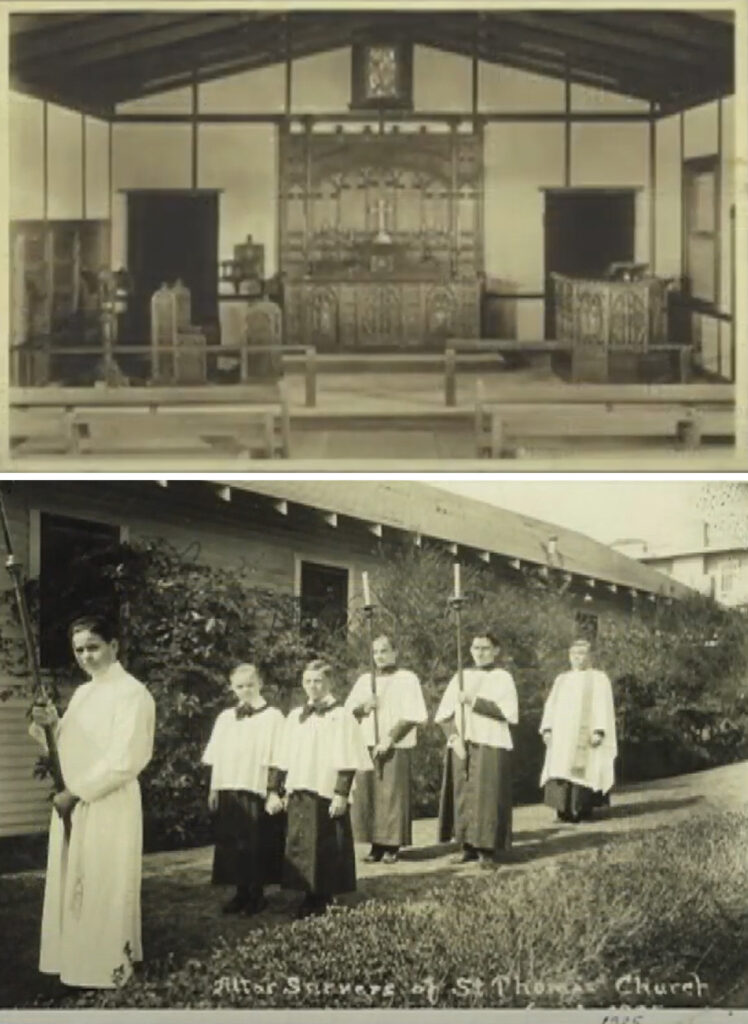
The current building was preceded on site for a decade by a small wooden church. At top is the interior of that church; above is a 1925 photo of altar servers gathering outdoors for a service. Photos courtesy of St. Thomas’ Church
Some two years later, in 1920 – when Bishop Joseph H. Johnson assigned St. Thomas’s parish boundaries reaching from Gardner Street west to Doheny and south to Melrose – the influenza pandemic had claimed some 3,000 lives in Los Angeles citywide, 675,000 nationally, and 50 million globally.
At that time, parish leaders would not have imagined that 100 years later the COVID-19 crisis – with a death toll to date of 8,345 in Los Angeles County, 304,000 across the country, and 1.6 million worldwide – would require the parish centennial observance to pivot from in-person events to digital participation using YouTube livestreaming, a technology far evolved from that of the expansive silver screens of the landmark Golden Era movie theaters along then-fashionable Hollywood Boulevard.
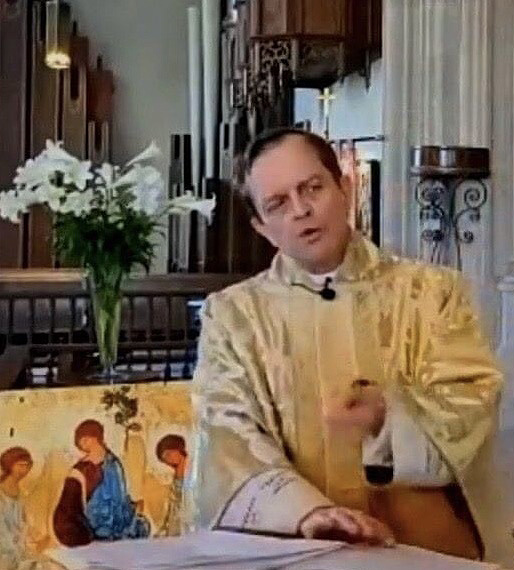
Preaching during an Eastertide digital service is the Very Rev. Canon Ian Elliot Davies, rector of St. Thomas the Apostle, Hollywood. Photo courtesy of St. Thomas’ Church
Likewise, in early 2020 when banners heralding the parish’s centennial year went up around the church, St. Thomas’s current rector, the Very Rev. Canon Ian Elliott Davies, and the congregation had no idea that their beloved sanctuary – home to beautiful liturgies in the Anglo-Catholic tradition – would two months later be closed for the foreseeable future.
There would be no in-person High Mass to mark the 100th year, no packed pews for a recital on the church’s storied pipe organ, no more Saturday Breakfast Club serving the needy. But thanks to the diligent work of Davies and parishioners, there would be intentional pastoral care, rich virtual liturgies online, ingenuity, and innovation.
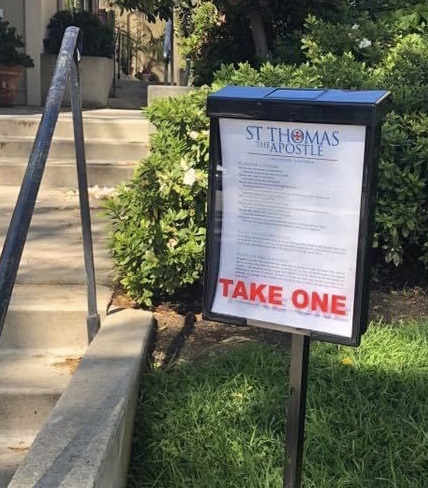
Flyers positioned along the sidewalk bring spiritual messages to passersby while the church buildings are closed. (Photo: Ed Tosca)
“We human beings find uncertainty very difficult,” Davies wrote in a circular made available in clear plastic boxes positioned outside along the sidewalk to neighbors and other passersby. “To bear it, we need two things in particular to be in place: clear guidance, and the support of other people, albeit through virtual communications.”
Fittingly, these factors combined into a new parish ministry approach titled “Digital Discipleship.” Senior Warden Ed Tosca works as part of a team to record and share almost daily Masses, including the popular weekly Saturday 5 p.m. Latin Vigil Mass averaging more than 400 views each, via the parish YouTube channel and Facebook page. A podcast, titled “Theologically Speaking,” is also available.
Tosca, who walks to church from his Hollywood Hills home three blocks east, cites the blend of technology and Anglo-Catholic liturgical consistency as especially appealing to “the large number of younger people” now logging into current services, which are receiving virtual attendance some four times higher than previous in-person liturgies.
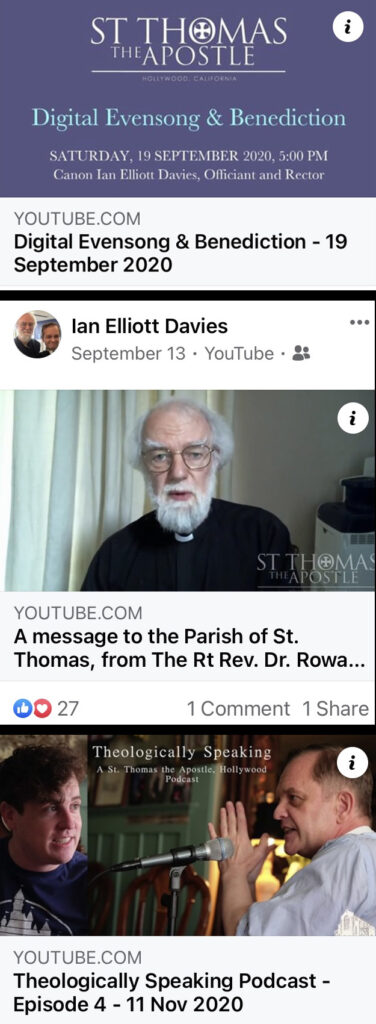
On the parish YouTube channel, daily posts feature events including the popular Evensong and Latin Vigil Mass services, a centennial message from Dr. Rowan Williams, and podcasts on theological topics. Photos courtesy of St. Thomas’ Church
“The younger people tell us they need a sense of order, and the Anglo-Catholic service, being the same every week, is calming and provides a rhythm of spirituality that is an anchor especially in these uncertain times,” Tosca said in a December telephone interview with The News.
“We worship in the beauty of holiness,” Tosca said, citing words from a familiar hymn. Also welcome is the parish value that “it’s ok to question,” he added, noting that faith is the antidote to doubt.
Tosca’s observation echoes the experience of the parish’s patron saint –“Doubting Thomas” among Jesus’ disciples – and with the legend of how the Hollywood congregation got its name, apparently chosen in 1913 because the bishop doubted the need for a mission church in the western hillsides and flatlands of Hollywood, then sparsely populated and dotted with orange groves. It seemed that Hollywood’s elder Episcopal parish – St. Stephen’s dating from 1897 – could continue to anchor local ministry. Beginning in 1912 with a church school hosted by Hollywood resident Mary Ogden in her living room, the parish’s history is recounted here. A brief documentary on parish history is here, and a video sampler of the parish’s liturgical expressions is here.
A highlight of the parish’s recent Digital Discipleship initiative was a video greeting and blessing from retired Archbishop of Canterbury Rowan Williams during the parish’s July 5 centennial patronal festival, an online virtual event. (Watch video here.) Williams gladly accepted the invitation from Davies, a fellow Welshman who hailed from London’s All Saints Margaret Street parish when called in 2001 to become St. Thomas’s eighth rector. His first service in Hollywood was March 1, 2002 on the Feast of St. David, patron of Wales.
Davies – a Diocesan Council member who also serves as dean of the Westside’s geographic Deanery 3 of Episcopal congregations – consistently emphasizes the importance of assisting those in the parish neighborhoods who are experiencing hunger and homelessness made worse by the COVID-19 crisis. He keeps foodstuffs and supplies ready for any who knock at the church doors in the current interim while the in-person weekly meals and food pantry are suspended.
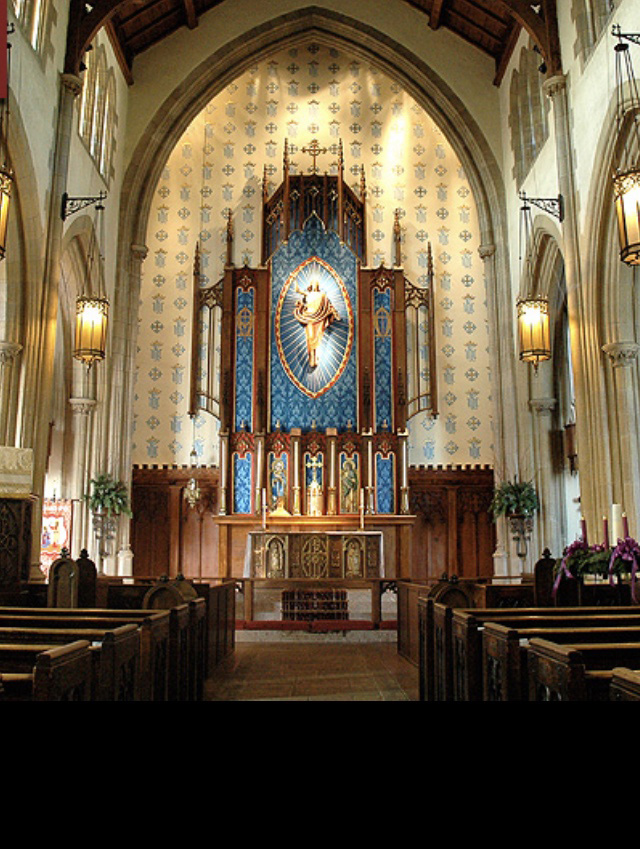
At Advent, the chancel of St. Thomas the Apostle Church, Hollywood.
“Our area makes immediately apparent the great disparity of homes worth many millions of dollars yet are cheek-by-jowl with those who are homeless,” Davies recently told The News. “And since COVID, the disparity has become even more apparent.”
Now – particularly with Christmastide and the traditional Dec. 21 observance of St. Thomas’ Day approaching – the parish will continue to do all it can to assist those in need.
Davies points to the priority historically placed upon community outreach and social service by the tradition of Anglo-Catholicism lived out in congregations around the world. Living out this unique calling has been a hallmark of St. Thomas’ parish, he said, especially starting in the 1980s with the congregation’s strong and longstanding solidarity with those living with HIV/AIDS and their caregivers.
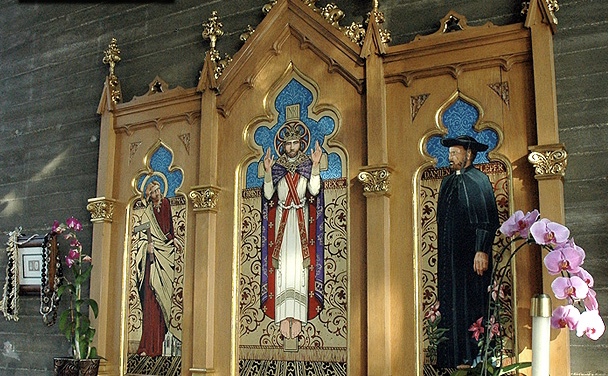
The chapel reredos depicts Christ as High Priest flanked by St. Thomas (at left) and St. Damien, missionary to the lepers of Molokai. Named for St. Damien, the chapel houses the AIDS Memorial at St. Thomas the Apostle Church, Hollywood. Photo courtesy of St. Thomas’ Church
Remembering: 15,000 names and counting
“Fr. Robert Alan Kettelhack” is the first entry on page 88 of the parish Book of Remembrance, a central focus of the parish’s AIDS Memorial in a chapel named for St. Damien, caregiver of lepers in the Molokai Colony. The list continues: “Jacques Girard Petrasek, Eugene Richard Werner, Paul E. Jacobsen, George Kelly, John Lovato, Ron Roth…” filling two columns on each page — totalling more than 15,000 names. Each year on All Souls’ Day, all names are read aloud. (See video here.) Full information about St. Damien’s Chapel and the AIDS Memorial is here.

Detail of some 15,000 names recorded in the AIDS Memorial Book at St. Thomas the Apostle, Hollywood. The Rev. Robert Kettlehack was the first priest of the Diocese of Los Angeles to die in the pandemic. Photo courtesy of St. Thomas’ Church
Kettlehack, who succumbed in 1989, was the first priest of the Diocese of Los Angeles to die of conditions related to AIDS. A parish associate at St. Thomas’, he was the life partner of the late Canon Jack Plimpton who, compelled by all that Kettelhack and he experienced amid the crisis, went on to found Project New Hope residential housing for individuals and families living with HIV/AIDS. Plimpton was also hired by Bishop Frederick H. Borsch to serve as the diocese’s first executive director of AIDS Ministries, a large program that included job-retraining in data-processing and providing lunches each weekday outside the clinic at L.A. County-USC Medical Center as an outreach of the Bishop’s Commission on AIDS Ministries. In the mid-1980s, Bishop Diocesan Robert C. Rusack and Bishop Suffragan Oliver B. Garver Jr. laid a foundation for the ministry that followed.
During this time, the Rev. Carroll Barbour was called in 1986 to serve as St. Thomas’ seventh rector. Early in his tenure, Barbour and parish leaders discerned the call to adopt Anglo-Catholicism as a way of parish life, a decision credited with many merits, including drawing in larger attendance than previously known in the immediately previous years of “broad church” liturgical expression. After conducting a formal research survey, the vestry determined that Anglo-Catholic liturgies also particularly drew in those formed in Roman Catholic and Orthodox, as well as Protestant, traditions. Also key was specific new outreach to the newly formed City of West Hollywood’s large population of LBGTQ residents. So significant was Barbour’s ministry at St. Thomas’ that the Los Angeles Times devoted a front-page story to his retirement.
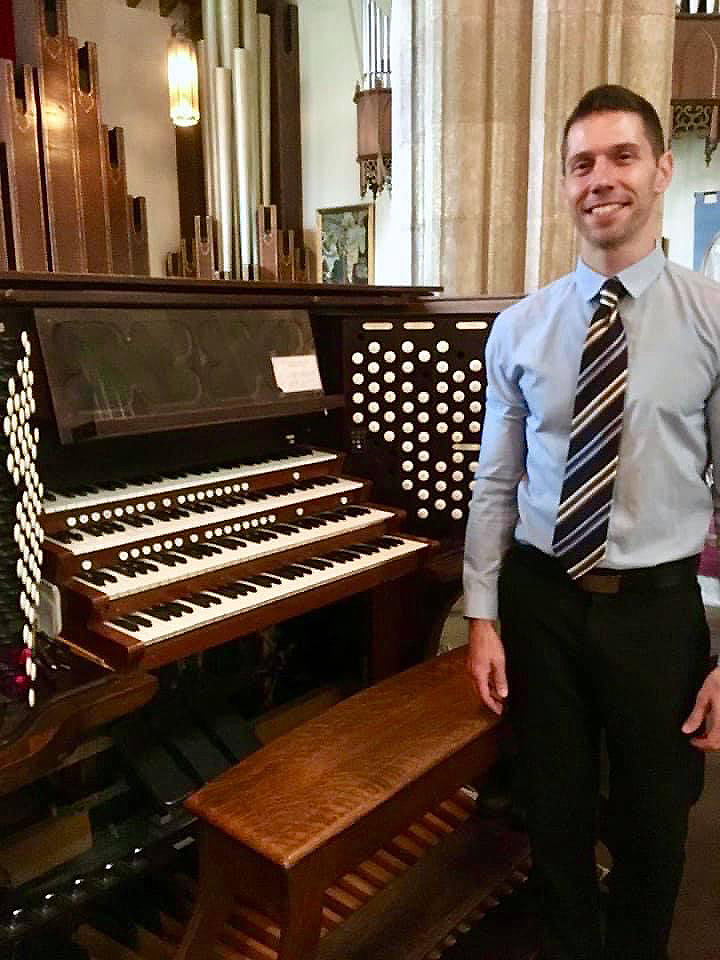
Dr. Jeffrey Parola, parish music director, stands at the console of the historic pipe organ at St. Thomas the Apostle, Hollywood. Photo courtesy of St. Thomas’ Church
Another significant parish remembrance of the lives of those affected by HIV/AIDS is St. Thomas’ Memorial Organ. A number of the instrument’s 3,800 pipes have been contributed by, or in memory of, persons living with HIV/AIDS. The instrument has been refined by various major repairs and enhancements since its installation in 1988-1990 by master organ builders Weston Harris of West Hollywood and Thomas J. McDonough of Point Fermin. The core of the instrument is the organ built in 1904 for Christ Episcopal Church, once located in downtown Los Angeles and for many decades closed. The instrument was acquired and installed in 1915 by downtown’s nondenominational Church of the Open Door, where the organ served for 70 years until the congregation relocated to the East San Gabriel Valley. Full history of the organ is here, and a related video, hosted by Robert Patrick, is here.
Dr. Jeffrey Parola, parish music director, oversees an annual Schola concert program and various organ recitals in addition to leading the parish choir and other service music. Senior warden Tosca credits Parola particularly for the care and expertise with which he has provided music digitally through the pandemic. The recent Digital Discipleship recordings also complement previous liturgical and musical offerings available via YouTube and spanning more than six years.
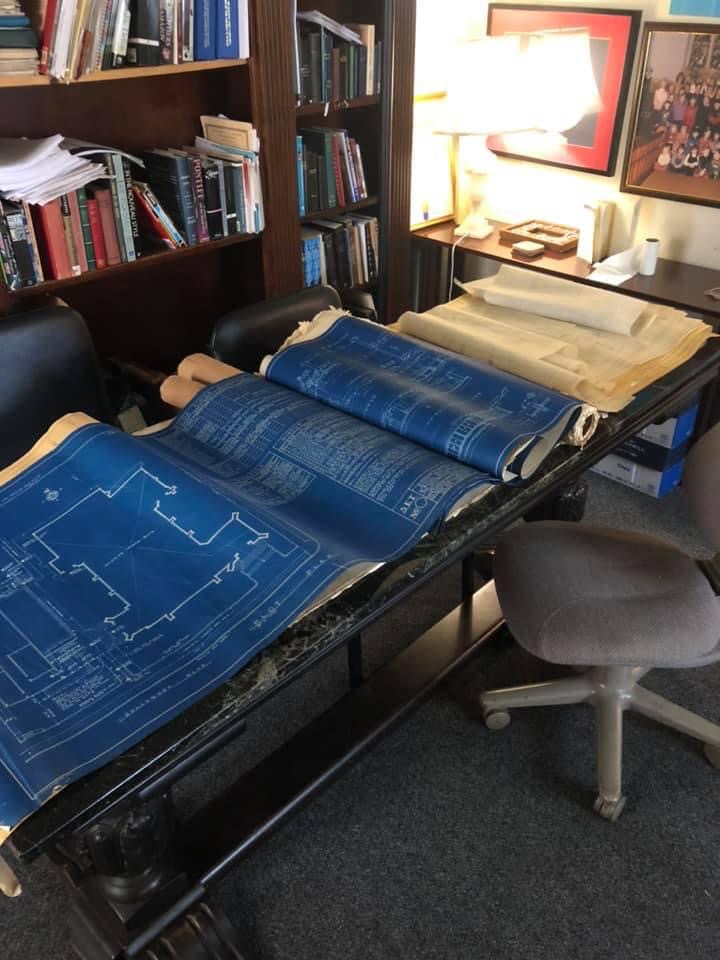
Dating from 1929-30, the original blueprints of St. Thomas’ Church were conveyed to the parish unexpectedly via a neighbor’s yard sale earlier this year. (Photo: Ed Tosca)
Roll credits
Because St. Thomas’ parish history overlaps the unfolding of Hollywood as the movie capital of the world, there are various church connections with productions and celebrities, a topic perhaps best left as the subject of a future article. The intersections range from providing filming locations for scenes ranging from the “Dynasty” wedding of Alexis Carrington, to recent reality shows, to Golden Era friendships of parish secretary Beatrice Boyd (mother of the late Rev. Canon Malcolm Boyd) with legendary actors Mary Pickford and Lillian Gish.
But recent kudos are due another type of star: Anthony “Tony” Zubick, an architect who had come into possession of most of the original blueprints and renderings of St. Thomas’s current 1930 church building, designed by Harold H. Martin who also designed Trinity Episcopal Church in Santa Barbara and was among architects of the Washington National Cathedral. In a chance meeting concurrent with a yard sale near the church, Zubick, who was relocating to Scotland, presented the drawings to senior warden Tosca, who described the experience as “completely unexpected serendipity.”
Presentation of the drawings is among highlights of the parish’s COVID-season experience, even as many more months of social distancing are on the horizon. To cope with those days, rector Davies points to the importance of resilience: “To survive this indefinite period of response to an unknown virus, we will need resilience,” he observed in one of his messages penned for circulation in the parish neighborhood.
“Diane Coutu has written that resilience ‘is one of the great puzzles of human nature, like creativity or the religious instinct.” She identifies three relevant aspects of resilience: ‘facing down reality,’ ‘the search for meaning,’ and ‘ritualized ingenuity.’
“Resilient people have a down-to-earth view of the need for survival and to recognize the danger of using denial as a coping mechanism,” Davies continued. “Facing up to the need for self-isolation and social distancing is essential if we are to prevent the voracious spread of the virus.
“When it comes to the search for meaning, we as the Episcopal parish and presence in this part of Hollywood are able to offer pointers in faith and the experience of being among communities and neighborhoods such as this one for 2,000 years, in good times and bad.”
— Canon for Common Life Robert Williams is appointed historiographer-archivist of the Diocese of Los Angeles.
